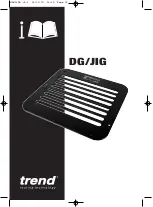
ETP SRB81-300-20-D
Safety Information
© Atlas Copco Industrial Technique AB - 9834 6192 00
3
Technical Data
Product Data
Motor voltage
36 V d.c.
Motor power
1500 W
Speed
103 r/min
Torque range
90 - 300 Nm (66.5 - 220 ft lb)
Weight
3.6 kg (8.0 lb)
Charger Compatibility
Accessory
Article nr.
Flex charger
4211 6083 84
Ambient Temperature
Operating temperature, charge
+5 to +40 °C
(+41 to +104 °F)
Operating temperature, discharge
0 to +40 °C
(+32 to +104 °F)
Storage temperature
−20 to +40 °C
(−4 to +104 °F)
Charger Temperatures
Charger operating tempera-
ture
+5 to +40 °C
(+41 to +104 °F)
Battery Compatibility
Accessory
Article nr.
Battery, 36V (2.5Ah)
4211 6030 86
Wireless LAN Information
Regulatory Do-
main
Band
TxChannels
WORLD
2.4 GHz
1, 2, 3, 4, 5, 6, 7, 8,
9, 10, 11
U-NII-1
36, 40, 44, 48
U-NII-2
52, 56, 60, 64
U-NII-2e
100, 104, 108, 112,
116, 132, 136, 140
U-NII-3
-
ETSI
2.4 GHz
1, 2, 3, 4, 5, 6, 7, 8,
9, 10, 11, 12, 13
U-NII-1
36, 40, 44, 48
U-NII-2
52, 56, 60, 64
U-NII-2e
100, 104, 108, 112,
116, 120, 124, 128,
132, 136, 140
U-NII-3
149, 153, 157, 161,
165
FCC
2.4 GHz
1, 2, 3, 4, 5, 6, 7, 8,
9, 10, 11
U-NII-1
36, 40, 44, 48
U-NII-2
52, 56, 60, 64
U-NII-2e
100, 104, 108, 112,
116, 132, 136, 140
U-NII-3
149, 153, 157, 161,
165
Maximum Radio Output Power
Radio Technology
Frequency Range
(MHz)
Maximum Trans-
mit Power EIRP
(dBm)
Wi-Fi®
2412-2472
19.1
Wi-Fi®
5180-5320
16.6
Wi-Fi®
5500-5700
17.3
Wi-Fi®
5745-5825
13.1
Bluetooth® wire-
less technology /
Bluetooth® Low
Energy
2402-2480
13.7
Wi-Fi® is a registered trademark of Wi-Fi Alliance®
The Bluetooth® word mark and logos are registered trade-
marks owned by Bluetooth SIG,Inc.
Declarations
Liability
Many events in the operating environment may affect the
tightening process and shall require a validation of results. In
compliance with applicable standards and/or regulations, we
hereby require you to check the installed torque and rota-
tional direction after any event that can influence the tighten-
ing result. Examples of such events include but are not lim-
ited to:
• initial installation of the tooling system
• change of part batch, bolt, screw batch, tool, software,
configuration or environment
• change of air- or electrical connections
• change in line ergonomics, process, quality procedures
or practices
• changing of operator
• any other change that influences the result of the tighten-
ing process
The check should:
• Ensure that the joint conditions have not changed due to
events of influence.
• Be done after initial installation, maintenance or repair
of the equipment.
• Occur at least once per shift or at another suitable fre-
quency.




































